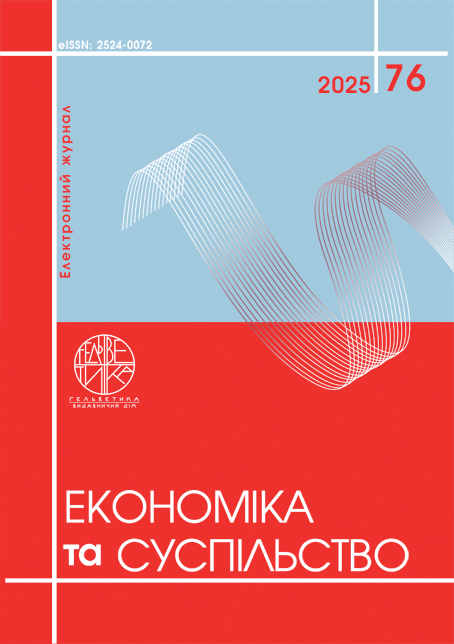HUMAN RESOURCES FOR IMPLEMENTATION OF THE BUSINESS DEVELOPMENT STRATEGY IN MARTIAL ARTS CONDITIONS: CHALLENGES, RESOURCES, DIGITAL SOLUTIONS
Abstract
The article considers the complex issues of personnel support for the implementation of enterprise development strategies under martial law. An analysis of the transformations of the business environment in Ukraine after the start of full-scale aggression was carried out, and the main challenges that complicate strategic planning and the functioning of organizations were identified. It is proven that effective personnel management is a key factor in the adaptation and long-term growth of companies, especially critical in conditions of instability, personnel migration and mobilization pressure on the labor market. Based on the system analysis, a personnel support mechanism was formed, which includes five blocks: target orientation, resource structuring, mechanisms for staff growth and retention, institutional support and internal consolidation of resources and actions. In addition, the main threats to the successful implementation of strategies were identified - from financial and institutional uncertainty to psychological exhaustion of employees. Special attention is paid to the use of digital technologies that provide flexibility, analytics, efficiency and increase the efficiency of management processes. Recommendations for integrating the HR vector into strategic management are summarized, with an emphasis on non-financial motivational methods and support for the psycho-emotional health of personnel. Despite limited resources, an unstable regulatory field and difficulties with personnel, many Ukrainian enterprises demonstrate a high level of flexibility, adaptability and innovative initiative. One of the key conclusions is that systematic staffing, built on the principles of strategic HRM, is able not only to compensate for personnel losses, but also to create new growth points. Internal training, development of a personnel reserve, digitalization of personnel management processes are approaches that have proven their effectiveness both in conditions of stability and in times of crisis. The conclusion is made that Ukrainian enterprises can successfully implement survival and development strategies through institutional flexibility, technological development and strengthening of human capital.
References
Амосов О.Ю. Процес формування та розвитку робітничих кадрів на підприємстві: теоретичний аспект. Теорія та практика державного управління. 2014. № 4. С. 165-168.
Канцур, І., Меліневський, А., & Супруненко, С. (2023). Цифрова трансформація в управлінні бізнесом в умовах сучасних викликів. Via Economica, (3), 42-47.
Кришталь, Г. О., Цімошинська, О. В., & Хіміч, С. В. (2024). Управління ефективністю цифрової трансформації підприємницьких структур: огляд наукових досліджень. Наукові праці Міжрегіональної Академії управління персоналом. Економічні науки, (4 (76)), 104-110.
Крушельницька О.В., Мельничук Д.П. Управління персоналом: навч. посібник. 2-ге вид. К.: Кондор, 2005. 308 с.
Левицький, В. В., Радинський, С. В., Артеменко, Л. Б., & Радинська, С. (2024). Підприємництво України в умовах війни та цифровізації: можливості та перспективи удосконалення. In Трансформація бізнесу для сталого майбутнього: дослідження, цифровізація та інновації: монографія (pp. 235-253).
Мельник О.Г. Організаційні зміни: сутність та види. Науковий вісник НЛТУ України. 2009. №19. 3. URL: https://nv.nltu.edu.ua/Archive/2009/19_3/231_Melnyk_19_3.pdf
Олексенко Р.І. Управління кадровими ресурсами підприємств у сучасних умовах господарювання. Агросвіт. 2010. № 14. С. 41-45. URL: http://www.agrosvit.info/pdf/14_2010/10.pdf
Legner, C., Eymann, T., Hess, T., Matt, C., Böhmann, T., Drews, P., ... & Ahlemann, F. (2017). Digitalization: opportunity and challenge for the business and information systems engineering community. Business & information systems engineering, 59, 301-308.
Koster, Ferry, and Luc Benda. "Innovative human resource management: measurement, determinants and outcomes." International Journal of Innovation Science 12.3 (2020): 287-302.
Gërxhani, K., & Koster, F. (2015). Making the right move. Investigating employers’ recruitment strategies. Personnel Review, 44(5), 781-800.
Doherty, N. (1998). The role of outplacement in redundancy management. Personnel Review, 27(4), 343-353.
Tzafrir, S. S. (2005). The relationship between trust, HRM practices and firm performance. The International Journal of Human Resource Management, 16(9), 1600-1622.
Amosov O.Yu. The process of formation and development of workers at the enterprise: a theoretical aspect. Theory and practice of public administration. 2014. No. 4. P. 165-168.
Kantsur, I., Melinevsky, A., & Suprunenko, S. (2023). Digital transformation in business management in the context of modern challenges. Via Economica, (3), 42-47.
Kryshtal, G. O., Tsimoshinska, O. V., & Khimich, S. V. (2024). Managing the effectiveness of digital transformation of business structures: a review of scientific research. Scientific works of the Interregional Academy of Personnel Management. Economic Sciences, (4 (76)), 104-110.
Krushelnytska O.V., Melnychuk D.P. Personnel management: a textbook. 2nd ed. K.: Condor, 2005. 308 p.
Levytskyi, V. V., Radynskyi, S. V., Artemenko, L. B., & Radynska, S. (2024). Entrepreneurship of Ukraine in the conditions of war and digitalization: opportunities and prospects for improvement. In Business Transformation for a Sustainable Future: Research, Digitalization and Innovation: Monograph (pp. 235-253).
Melnyk O.G. Organizational Changes: Essence and Types. Scientific Bulletin of NLTU of Ukraine. 2009. No. 19. 3. Available at: https://nv.nltu.edu.ua/Archive/2009/19_3/231_Melnyk_19_3.pdf.
Oleksenko R.I. Management of Human Resources of Enterprises in Modern Economic Conditions. Agrosvit. 2010. No. 14. P. 41-45. Available at: http://www.agrosvit.info/pdf/14_2010/10.pdf
Legner, C., Eymann, T., Hess, T., Matt, C., Böhmann, T., Drews, P., ... & Ahlemann, F. (2017). Digitalization: opportunity and challenge for the business and information systems engineering community. Business & information systems engineering, 59, 301-308.
Koster, Ferry, and Luc Benda. "Innovative human resource management: measurement, determinants and outcomes." International Journal of Innovation Science 12.3 (2020): 287-302.
Gërxhani, K., & Koster, F. (2015). Making the right move. Investigating employers’ recruitment strategies. Personnel Review, 44(5), 781-800.
Doherty, N. (1998). The role of outplacement in redundancy management. Personnel Review, 27(4), 343-353.
Tzafrir, S. S. (2005). The relationship between trust, HRM practices and firm performance. The International Journal of Human Resource Management, 16(9), 1600-1622.

This work is licensed under a Creative Commons Attribution 4.0 International License.


